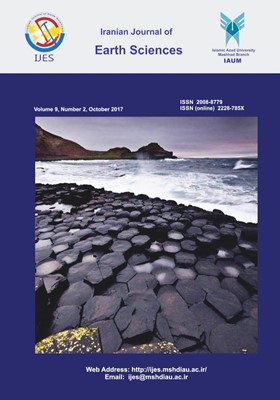Determination of a Conceptual Model for the Structural Features and Pb–Zn Mineralization in the North of Behabad Fault Zone, Central Iran
محورهای موضوعی : MineralogyAhmad Adib 1 , Shapour Mirzaei Ilani 2 , GholamReza Shoaei 3 , Peyman Afzal 4
1 - Department of Petroleum Engineering, South Tehran Branch, Islamic Azad University, Tehran, Iran
2 - Zamin Kav Environmental & Geology Research Center, Tehran, Iran,
3 - Department of Geology, Tarbiat Modares University, Tehran, Iran
4 - Department of Mining Engineering, South Tehran Branch, Islamic Azad University, Tehran, Iran
کلید واژه: conceptual model, Conceptual Model, non-sulfide mineralization, Behabad fault, Kuhbanan fault,
چکیده مقاله :
The Behabad region is located within a tectono–sedimentary zone in southeast Yazd province, Central Iran. The tectonic activities have deformed and faulted the Mesozoic and Quaternary formations in this area. The faults in Kuhbanan and Behabad have played a key role in the evolution of geological events, mineralization, and the formation of Behabad–Kuhbanan horst. These faults have separated the Posht-e-Badam block from the Tabas block and the Behabad zone from the Abdoghi–Ravar tectonic zone, respectively. Remote-sensing techniques and field observations show that the Pb–Zn veins share similar trends with the structures. The compressional system induced by the activities of the Behabad-1 and 2 fault systems have caused the formation of thrusts, drag, and sigmoidal folds, the North Behabad horst, and shear zones containing Pb–Zn mineralization. The Mississippi Valley-type (MVT) deposits and strata band mineralization types are present in the study area. In terms of the temporal phase controller, it is consistent with the tectonic-magmatic model of the Late Paleozoic–Triassic period; in terms of the spatial controller, mineralization is situated in the tectonic–metallogeny province of Central Iran and the ore deposits that mainly follow the geometry of the thrust faults’ crushed zones. The thrust fault that drives the dolomite unit over the limestone is the main cause of the ore solutions migration. According to the MVT mineralization and the correlation between structures and mineralization, the sulfide deposits can be potentially found at the base of the Permo–Triassic units in the studied area. There are several active and non-active Zn–Pb mines such as Abheydar, Rikalaghi, and Tapesorkh.
The Behabad region is located within a tectono–sedimentary zone in southeast Yazd province, Central Iran. The tectonic activities have deformed and faulted the Mesozoic and Quaternary formations in this area. The faults in Kuhbanan and Behabad have played a key role in the evolution of geological events, mineralization, and the formation of Behabad–Kuhbanan horst. These faults have separated the Posht-e-Badam block from the Tabas block and the Behabad zone from the Abdoghi–Ravar tectonic zone, respectively. Remote-sensing techniques and field observations show that the Pb–Zn veins share similar trends with the structures. The compressional system induced by the activities of the Behabad-1 and 2 fault systems have caused the formation of thrusts, drag, and sigmoidal folds, the North Behabad horst, and shear zones containing Pb–Zn mineralization. The Mississippi Valley-type (MVT) deposits and strata band mineralization types are present in the study area. In terms of the temporal phase controller, it is consistent with the tectonic-magmatic model of the Late Paleozoic–Triassic period; in terms of the spatial controller, mineralization is situated in the tectonic–metallogeny province of Central Iran and the ore deposits that mainly follow the geometry of the thrust faults’ crushed zones. The thrust fault that drives the dolomite unit over the limestone is the main cause of the ore solutions migration. According to the MVT mineralization and the correlation between structures and mineralization, the sulfide deposits can be potentially found at the base of the Permo–Triassic units in the studied area. There are several active and non-active Zn–Pb mines such as Abheydar, Rikalaghi, and Tapesorkh.


